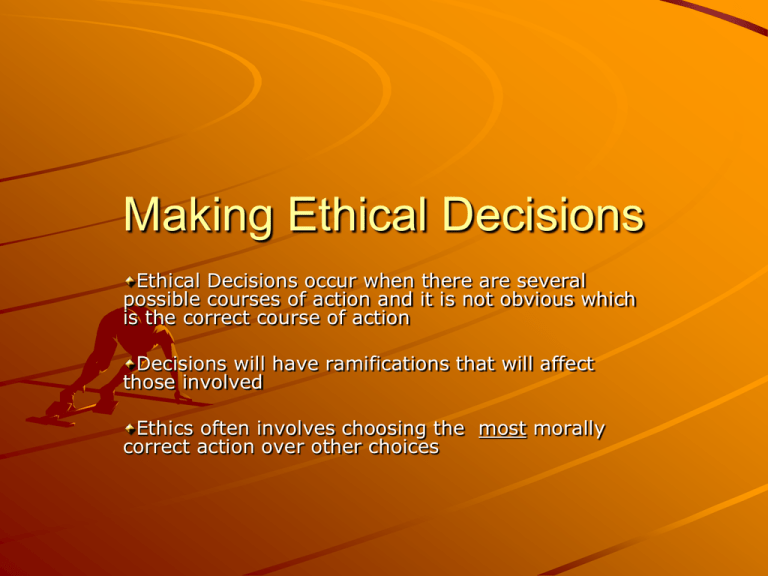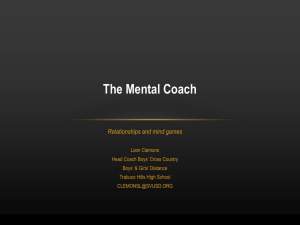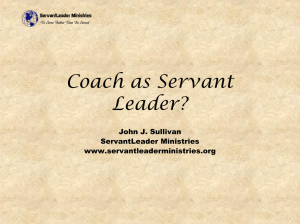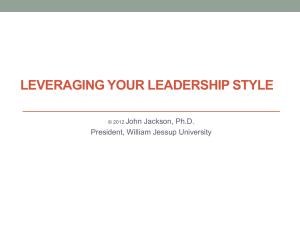Making Ethical Decisions
advertisement

Making Ethical Decisions Ethical Decisions occur when there are several possible courses of action and it is not obvious which is the correct course of action Decisions will have ramifications that will affect those involved Ethics often involves choosing the most morally correct action over other choices To Play or Not to Play Read the Situation presented on Page 12 of Ethical Decision Making in the Workbook. “Jamie has just been named the head coach of her sport organization. She has noticed that one of the athletes seems to suffer from a knee ...” Decision Making Process For Ethical Thinking 1. 2. 3. 4. 5. 6. 7. Get all the facts and both sides of the issue Ask yourself, is it a legal matter or ethical? Identify the issues, what is at stake in this decision Identify possible actions to take and the potential consequences of each Assess the Pros and Cons of each of action Select a course of action Implement the decision 1. Getting The Facts Take time to get information before giving a response. Think before you speak. Be sure to act only after hearing all sides of the story. Don’t decide based on one person’s spin. Write the facts in point form Facts The athlete is a minor The athlete shows symptoms of injury Everyone (coach, parents, athlete, doctor) agree on symptoms Parents demand their child participate. Refer to opinion of the Family MD to justify no risk No written proof from a doctor on their opinion/diagnosis Coach background leads her to believe situation serious and could have long term health consequences Athlete is talented with a shot at the provincial team Policy of the organization gives coach final say on allowing an athlete to participate Another policy says written medical permission is needed to return to the sport after an injury Before the competion the athlete confirms the pain but is willing to play Provincial coach came a long way to scout the athlete today 2. Legal or Ethical Any issue of abuse (mental or physical) is a legal matter. Any issue that breaks the law is a legal matter. If the issue is a legal matter notify the authorities and they deal with it. If the issue is not a legal matter proceed with the decision process This is not a legal issue. This has ethical implication Continue on with the decision process to the next step and determine what issues are at stake. 3. Issues At Stake Your action or non action can affect your authority as coach and the respect and discipline of the team as well as its supporters toward you. In this section you write down the issues at risk depending on your action or non action as coach. List what is at risk. • • • • • • Issues at stake: Long term health of the athlete is at risk Respect for the policies of the organization Responsibility of the coach to make the decision Appropriate use of power (as a coach to an athlete and a parent’s authority over their child) Individual goals – the chance to compete provincially 4. Possible Actions and Consequences List the possible actions you could take. Do this in clear words and in point form. When thinking of actions a good start is to think: What would happen if I did nothing What would happen if I took the most extreme pro action What would happen if I took the most extreme con action Is there a middle ground option? What are your Options? Coach makes no intervention and allows the parents to proceed Coach decides to allow the athlete to compete Coach decides not to let the athlete compete 5. Pros and Cons List the possible action. Underneath write out all the pros you can think of for this action. Then write out all the cons for the same action. Use point form and clear language. Do this for each possible action you have identified. Coach makes no intervention and allows the parents to proceed The athlete competes and will have a chance to be selected; he/she will run the risk of doing more damage to the injury; the parents not the coach are making the decision;the coach abdicates her responsibilities for the athlete; a conflict with the parents is avoided. Coach allows the athlete to compete The athlete will compete and will have a chance to be selected; he/she runs the risk of doing more injury to to their body; the coach assumes his or her decision-making authority; a conflict with the parents is avoided. The coach’s authority is enforced. The coach decides to not allow the athlete to compete The athlete will not compete and his/her chances of being selected may be compromised; he/she will not run a risk of further injury; the coach assumes her decision-making authority; a conflict with the parents may erupt; the provincial coach came a long way for nothing. 6. Before Selecting your Action consider such things as: Choosing the decision that best reflects or preserves your values Is the action consistent with team rules, expectations and past actions you have taken; does it set a precedent? Ask is my decision just and fair for all concerned Consider if you have any bias that may affect your judgment Your Decision and Defence I would allow the athlete to compete. I cannot be certain the athlete’s participation will cause further injury although I believe it is a risk. I have conveyed my feelings to both athlete and parents. Because the parents, athlete and, by their word, the family MD believe he can compete I concede to the parental authority over mine as coach. Implementing the Decision Once you have your decision you need to consider the best way to announce it. Tact and sensitivity help people to understand your actions. Consider: Who needs to be told When and where to tell them Who else should be involved Be prepared to justify your reasons Ethical Decisions Your team has just lost a close game to a tough opponent. It was a rough game and one of your players is refusing to shake hands after the game on the grounds he was mistreated by the other team. Her parents are in agreement and encouraging him to leave. It is a team rule that you shake hands after every game. What are the facts Close game Tough game Athlete felt disrespected, mistreated Athlete is upset and angry ?? Refuses to shake hands Parents don’t want her to shake hands Team rule broken You are witnessing it Is this a legal issue No Treat it as an Ethical Situation Continue with decision process What are the Issues • • • • • Sportsmanship Team rules being violated Coaches authority with players Leadership coach vs parents Team image Possible Actions 1. Do nothing 2. Suspend athlete for a game 3. Confront athlete and parents and insist athlete shake hands on the spot 4. Have a meeting of team and parents before the next game to review the team tradition of shaking hands and its importance and to indicate it will not be tolerated in future. 5. Do nothing then, wait till later to talk to athlete and parents. Review rule and as a condition to stay on the team she must apologize to team for action and understand another incident could lead to more serious action Weigh Pros and Cons 1. No Action By taking no action there is no ugly scene Rule is disrespected and others may feel they don’t need to follow it either Team image is hurt Some parents and athletes lose respect for coach and her authority 2. Suspend athlete for a game • • • May upset the athlete and parents who feel they did nothing wrong Reinforces the rules and the coach’s authority Preserves team image 3. Confront athlete and parents and insist on shaking hands on the spot • • • Too immediate and could result in an ugly scene with the parents/athlete May escalate the problem Upholds coach’s authority, team rules, team image, respect from players and parents Weighing Pros and Cons 4 Have a meeting of team and parents before the next game to review the team tradition of shaking hands and its importance and to indicate it will not be tolerated in future. • • • • Does not address the guilty party Unfair to those who follow the rule Team image suffers Coach’s authority weakened 5. Do nothing then, wait till later to talk to athlete and parents. Review rule and ask athlete to apologize to team and other coach for action and understand another incident could lead to more serious action • • • • Avoids ugly scene Gives athlete a second chance Reinforces rules May show a lack of importance for the rule since there was no immediate consequence for breaking the rule Team image may suffer Gives athlete the choice • • Select an Action Suspend athlete for a game Upon reflection this preserves most of my values and is something as coach I feel I can defend if questioned • • • • • Avoids ugly scene and escalation of problems Upholds the team rule with consequences Directed only at the offender Upholds team image Maintains authority and leadership of coach Implementation • Must take place before the next practice or game • Have assistant coach present • Be sensitive and understanding of the athlete and parents feelings of upset but reinforce the importance of sportsmanship and the team handshake as the priority • Clearly state that on this team you don’t play unless you follow the team rules • Be polite but firm in your stance






